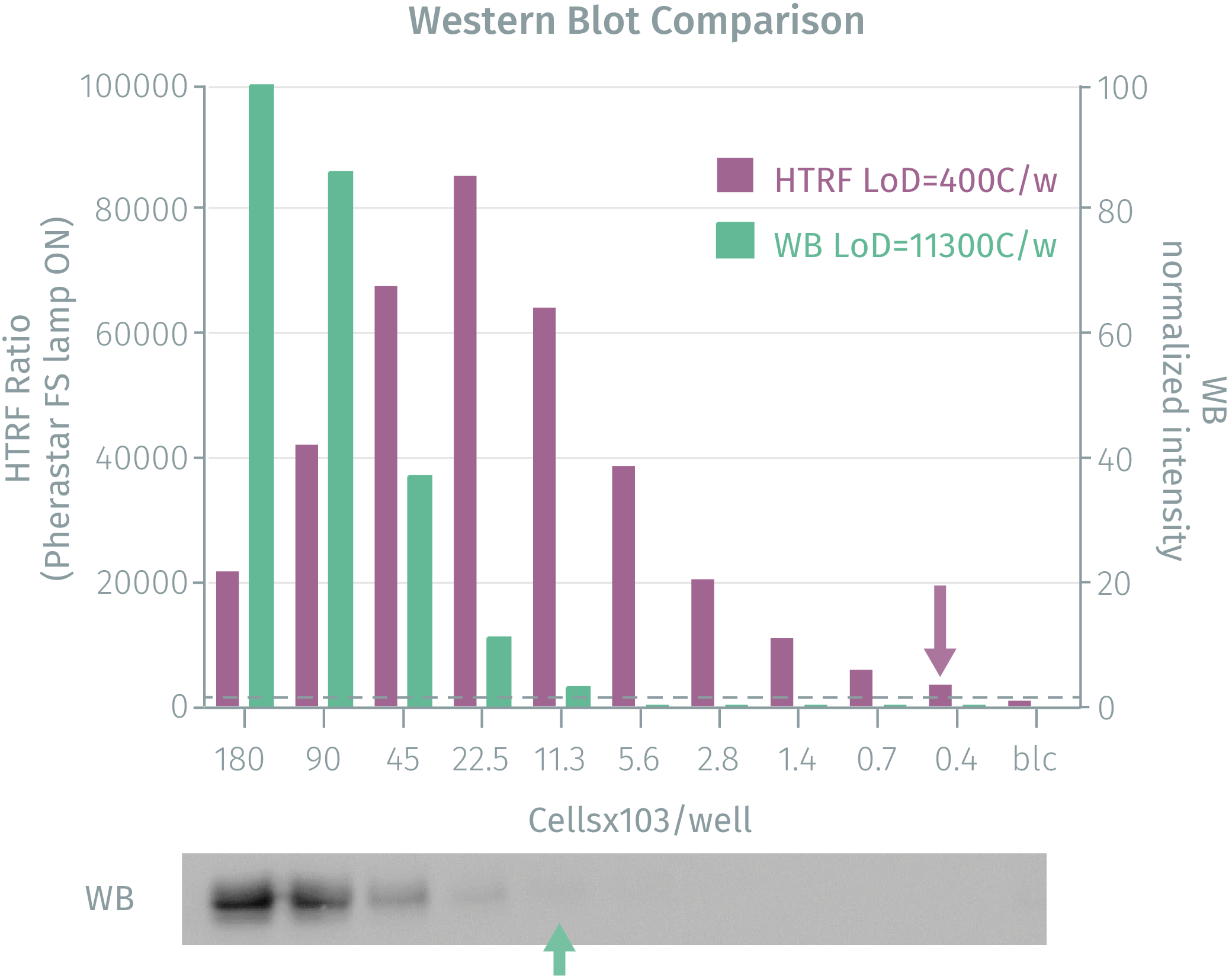

HTRF Human & Mouse Phospho-4EBP1 (Thr37/46) Detection Kit, 500 Assay Points


HTRF Human & Mouse Phospho-4EBP1 (Thr37/46) Detection Kit, 500 Assay Points






The phospho 4EBP1 (Thr37/46) kit measures cellular phospho-4EBP1, phosphorylated at Thr37/46, as an mTOR readout in the translational control pathway.
For research use only. Not for use in diagnostic procedures. All products to be used in accordance with applicable laws and regulations including without limitation, consumption and disposal requirements under European REACH regulations (EC 1907/2006).
| Feature | Specification |
|---|---|
| Application | Cell Signaling |
| Sample Volume | 16 µL |
The phospho 4EBP1 (Thr37/46) kit measures cellular phospho-4EBP1, phosphorylated at Thr37/46, as an mTOR readout in the translational control pathway.
For research use only. Not for use in diagnostic procedures. All products to be used in accordance with applicable laws and regulations including without limitation, consumption and disposal requirements under European REACH regulations (EC 1907/2006).



HTRF Human & Mouse Phospho-4EBP1 (Thr37/46) Detection Kit, 500 Assay Points



HTRF Human & Mouse Phospho-4EBP1 (Thr37/46) Detection Kit, 500 Assay Points



Product information
Overview
The phospho-4EBP1 assay kit is designed for the quantification of endogenous 4EBP1 protein, phosphorylated on Thr37/46. Based on the TR-FRET technology, the HTRF phospho-4EBP1 sandwich immunoassay provides an ideal readout solution in any cell type, for mTOR signaling and the translational control pathway. The optimized no-wash protocol facilitates mechanistic signaling pathway studies, analysis of compound mechanism of action, and target research, by delivering enhanced convenience and more relevant, reliable results.
Specifications
| Application |
Cell Signaling
|
|---|---|
| Brand |
HTRF
|
| Detection Modality |
HTRF
|
| Molecular Modification |
Phosphorylation
|
| Product Group |
Kit
|
| Sample Volume |
16 µL
|
| Shipping Conditions |
Shipped in Dry Ice
|
| Target Class |
Phosphoproteins
|
| Target Species |
Human
Mouse
|
| Technology |
TR-FRET
|
| Therapeutic Area |
Metabolism/Diabetes
|
| Unit Size |
500 Assay Points
|
Video gallery

HTRF Human & Mouse Phospho-4EBP1 (Thr37/46) Detection Kit, 500 Assay Points

HTRF Human & Mouse Phospho-4EBP1 (Thr37/46) Detection Kit, 500 Assay Points

How it works
Phospho-4EBP1 (Thr37/46) Assay principle
The Phospho-4EBP1 (Thr37/46) assay measures 4EBP1 when phosphorylated at Thr37/46. Contrary to Western Blot, the assay is entirely plate-based and does not require gels, electrophoresis or transfer. The Phospho-4EBP1 (Thr37/46) assay uses 2 labeled antibodies: one with a donor fluorophore, the other one with an acceptor. The first antibody is selected for its specific binding to the phosphorylated motif on the protein, the second for its ability to recognize the protein independent of its phosphorylation state. Protein phosphorylation enables an immune-complex formation involving both labeled antibodies and which brings the donor fluorophore into close proximity to the acceptor, thereby generating a FRET signal. Its intensity is directly proportional to the concentration of phosphorylated protein present in the sample, and provides a means of assessing the proteins phosphorylation state under a no-wash assay format.

Phospho-4EBP1 (Thr37/46) 2-plate Assay protocol
The 2 plate protocol involves culturing cells in a 96-well plate before lysis then transferring lysates to a 384-well low volume detection plate before adding Phospho-4EBP1 (Thr37/46) HTRF detection reagents. This protocol enables the cells' viability and confluence to be monitored.

Phospho-4EBP1 (Thr37/46) 1-plate assay protocol
Detection of Phosphorylated 4EBP1 (Thr37/46) with HTRF reagents can be performed in a single plate used for culturing, stimulation and lysis. No washing steps are required. This HTS designed protocol enables miniaturization while maintaining robust HTRF quality.

Assay validation
Phospho-4EBP1 HTRF assay performance compared to WB
Human HEK293 cells were grown in a T175 flask at 37°C until 80% confluency. After removal of cell culture medium, 3 mL of supplemented lysis buffer were added and incubated for 30 minutess. Soluble supernatants were collected after a 10 minute centrifugation. Equal amounts of lysates were used for a side by side comparison of Western Blot and HTRF. Using HTRF phospho-4EBP1 (THR37/46), just 400 cells are sufficient for minimal signal detection while 11,300 cells are needed for a Western Blot signal. The HTRF assay is 32-fold more sensitive than the Western Blot

Phospho-4EBP1 response upon mTORC1 activation
Jurkat, A431 and SW480 cells were seeded at 25,000 cells per well in a 96-well plate with DMEM+10%FCS for 24 hours. The cells were treated for 3 hours with known pan-mTOR inhibitors, either with increasing concentrations of PP242 or BEZ235. The two-plate adherent protocol was applied to A431 and SW480 cells, whereas the two-plate suspension protocol was followed for Jurkat cells.


Species compatibility: PP242 + Rapamycin in murine NIH3T3 cells
Murine NIH3T3 cells were incubated with various concentrations of tPP242 and Rapamycin, followed by stimulation with Insulin for 30 minutess at 37°C. After lysis, inhibition of 4EBP1 phosphorylation was measured using the HTRF phospho-4EBP1 (THR37/46) assay according to the two-plate protocol. PP242 is a potent pan-mTOR inhibitor of both mTORC1 (including Rapamycin-resistant 4EBP phosphorylation) and mTORC2, whereas Rapamycin treatment is known to have only partial or no effect on 4EBP1 phosphorylation.

Simplified pathway
Translation is initiated when a ribosome is recruited to the 5 end of an mRNA. The eIF4E-binding proteins, such as 4EBP1, block translation by binding to eIF4E and preventing recruitment of the translation machinery. Hypophosphorylated 4EBP1 downregulates translation, whereas 4EBP1 hyperphosphorylation by mTOR abrogates eIF4E-binding activity and therefore promotes translation. The assessment of cellular phospho-4EBP1 is an important tool to generally measure mTOR potency and to determine the activity of mTOR signaling.

Resources
Are you looking for resources, click on the resource type to explore further.
Discover the versatility and precision of Homogeneous Time-Resolved Fluorescence (HTRF) technology. Our HTRF portfolio offers a...
This guide provides you an overview of HTRF applications in several therapeutic areas.


How can we help you?
We are here to answer your questions.






























